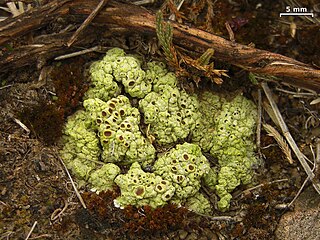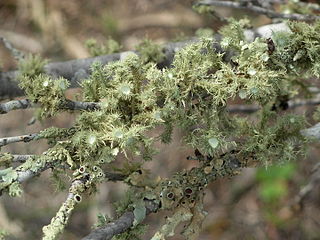Biatorellaceae is a family of lichen-forming fungi in the subclass Lecanoromycetidae. The family is monotypic, and contains the single genus Biatorella, which contains eight species.
Physcidia is a genus of lichen-forming fungi in the family Ramalinaceae. The genus was circumscribed in 1862 by American lichenologist Edward Tuckerman.
Menegazzia neozelandica is a species of foliose lichen from New Zealand, Australia, and South America. It was first described by Austrian botanist Alexander Zahlbruckner in 1929 as Parmelia neozelandica. Peter James transferred it to the genus Menegazzia in 1992.
Menegazzia stirtonii is a species of foliose lichen found in New Zealand, and Tasmania, Australia.
Menegazzia weindorferi is a species of foliose lichen found in Australia. It was originally described by Austrian botanist Alexander Zahlbruckner as a species of Parmelia in 1907. Rolf Santesson transferred it to Menegazzia in 1942.
Painted Peak, also called Painted Hill, is a prominent peak, 710-metre (2,330 ft), on the northern end of the North Masson Range in the Framnes Mountains, Mac. Robertson Land. It was aerially photographed in 1936-1937 and later mapped from these photos by Norwegian cartographers in 1946. It was first visited by an ANARE team in 1955. The ANCA named it for its prominent red-brown coloring. USACAN accepted the name in 1965. It was used as a tellurometer station in 1962.

Alexander Zahlbruckner was an Austrian-Hungarian botanist who specialized in the study of lichens. Johann Babtist Zahlbruckner, an earlier Austrian botanist, was his grandfather.
The University of Michigan Herbarium is the herbarium of the University of Michigan in Ann Arbor, Michigan, in the United States. One of the most-extensive botanical collections in the world, the herbarium has some 1.7 million specimens of vascular plants, algae, bryophytes, fungi, and lichens, and is a valuable resource for teaching and research in biology and botany. The herbarium includes many rare and extinct species.

The wildlife of Antarctica are extremophiles, having adapted to the dryness, low temperatures, and high exposure common in Antarctica. The extreme weather of the interior contrasts to the relatively mild conditions on the Antarctic Peninsula and the subantarctic islands, which have warmer temperatures and more liquid water. Much of the ocean around the mainland is covered by sea ice. The oceans themselves are a more stable environment for life, both in the water column and on the seabed.

Crustose lichens are lichens that form a crust which strongly adheres to the substrate, making separation from the substrate impossible without destruction. The basic structure of crustose lichens consists of a cortex layer, an algal layer, and a medulla. The upper cortex layer is differentiated and is usually pigmented. The algal layer lies beneath the cortex. The medulla fastens the lichen to the substrate and is made up of fungal hyphae. The surface of crustose lichens is characterized by branching cracks that periodically close in response to climatic variations such as alternate wetting and drying regimes.

Hermann Edward Hasse was an American lichenologist. He wrote two important texts and numerous articles in his field. Hassea, which is a genus of fungi in the class Dothideomycetes, and Lecidea hassei, a lichen that grows inside solid rock, were both named in his honor. He principally did his research in southern California. His correspondents included cryptogamic botanist William Gilson Farlow and lichenologist George Knox Merrill.

Acarospora schleicheri, the soil paint lichen, is a bleached to bright yellow areolate to squamulose lichen that commonly grows to 10 cm (4 in) on soil (terricolous) in arid habitats of southern California and Baja California, also in Europe and Africa. It produces rhizocarpic acid as a secondary metabolite, which gives it a yellow coloration and serves to protect it from the sun. Its lower surface is also yellow. It can be greenish when moist. Roundish, angular, or irregularly shaped squamules are 0.5–4 mm in diameter. There are 0–1 apothecia embedded in the thallus, with 0.4–1.2 mm roundish black to reddish-brown, or dark brown discs, which sometimes fill the areola so as to be lecanorine. It divides vegetatively on the soil. Asci are club shaped (clavate) and have 100 or more spherical to ellipsoid spores. Lichen spot tests are negative, and it is UV+ orange under ultraviolet light.

Usnea scabrida is a foliose lichen that grows from holdfasts on trees. It occurs in southwest Western Australia. It is a very pale grayish-yellowish green, slender, pendant, branching from the base, unequally branching, and shrubby. The cortex contains usnic acid, and the medulla contains scabrosins. The lichen was described as a new species in 1844 by English botanist Thomas Taylor.
Adolf Hugo Magnusson was a Swedish naturalist who specialized in lichenology. He was a school teacher in Gothenburg from 1909 to 1948, but spent his spare time on the study of lichens. He described about 900 new taxa, specializing in the genera Lecidea, Lecanora, Caloplaca, and Acarospora.
Trapelia thieleana is a lichenised fungus in the family, Trapeliaceae. It was first described in 2014 by the mycologists, Gintaras Kantvilas, Steven Leavitt, John Elix and Thorsten Lumbsch.

Trapelia coarctata is a lichenised fungus in the family, Trapeliaceae.

Mastodia is a genus of lichen-forming fungi in the family Verrucariaceae. It has six species.

Acarospora contigua is a species of saxicolous (rock-dwelling), crustose lichen in the family Acarosporaceae. It was formally described as a new species in 1929 by Swedish lichenologist Adolf Hugo Magnusson. The dark yellow thallus has a continuous smooth crust comprising areoles that are 1–2.5 mm in diameter. In North America, it is known as the gold cobblestone lichen. The lichen was reported from the Eastern Ghats India in 2021, where it occurs in tropical conditions at elevations between 500 and 1,000 m.

Flavoplaca maritima is a species of crustose lichen in the family Teloschistaceae. It is found in costal areas of Northern, Western, and Southern Europe. It mostly occurs on rocks, but has also been recorded growing on wood.









